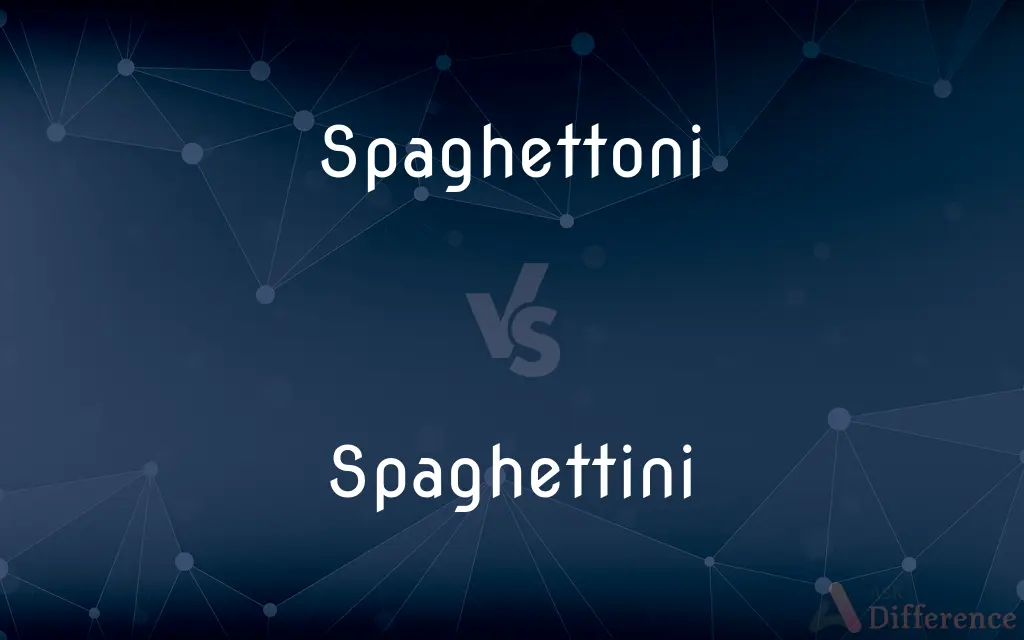Spaghettoni vs. Spaghettini — What's the Difference?
By Maham Liaqat & Fiza Rafique — Updated on March 25, 2024
Spaghettoni is a thicker version of spaghetti, offering a more robust texture, while spaghettini is thinner, providing a more delicate mouthfeel and quicker cooking time.

Difference Between Spaghettoni and Spaghettini
Table of Contents
ADVERTISEMENT
Key Differences
Spaghettoni and spaghettini are both variations of the classic spaghetti pasta, differentiated primarily by their thickness. Spaghettoni, with its larger diameter, is a heartier option that stands up well to thicker, more robust sauces. On the other hand, spaghettini is a finer version of spaghetti, characterized by its slender strands.
The thicker form allows for a more pronounced pasta texture in dishes, making it suitable for those who prefer a more substantial bite. Due to its thickness, spaghettoni typically requires a longer cooking time compared to standard spaghetti and thinner pasta varieties. The delicate nature makes spaghettini particularly well-suited for lighter sauces, such as simple oil or seafood-based sauces, allowing the subtle flavors to shine without being overwhelmed by the pasta. The thinness of spaghettini not only contributes to a more refined texture but also reduces its cooking time, making it a quick option for meals.
The choice between spaghettoni and spaghettini often comes down to personal preference and the type of sauce being served. While spaghettoni provides a more robust foundation for hearty sauces, spaghettini is ideal for dishes that require a gentler, more delicate pasta component. Both types offer unique culinary experiences, extending the versatility of spaghetti dishes beyond the traditional.
Comparison Chart
Thickness
Thicker than standard spaghetti.
Thinner than standard spaghetti.
Texture
Offers a robust, chewy texture.
Provides a delicate, finer mouthfeel.
ADVERTISEMENT
Suited Sauces
Heavier, robust sauces like meat sauces.
Lighter, more delicate sauces like oil-based.
Cooking Time
Longer due to its thickness.
Shorter due to its thinness.
Culinary Use
Ideal for hearty meals and textures.
Preferred for lighter, more refined dishes.
Compare with Definitions
Spaghettoni
A thicker variation of spaghetti, suitable for hearty dishes.
Spaghettoni paired with a rich Bolognese sauce is a fulfilling meal.
Spaghettini
Cooks quickly due to its thinness.
Spaghettini is ideal for a quick, yet elegant, weeknight dinner.
Spaghettoni
Requires a slightly longer cooking time.
When preparing spaghettoni, allow a few extra minutes for it to reach al dente.
Spaghettini
A finer, more delicate version of spaghetti.
Spaghettini tossed with garlic, oil, and chili flakes makes a light, aromatic dish.
Spaghettoni
Best matched with robust, thick sauces.
Spaghettoni with a hearty ragù offers a satisfying texture contrast.
Spaghettini
Suited for dishes that require a gentle pasta presence.
For a seafood pasta dish, spaghettini beautifully complements the tender textures of shellfish.
Spaghettoni
Provides a substantial bite and texture.
The chewiness of spaghettoni makes it perfect for absorbing bold flavors.
Spaghettini
Complements light and subtle sauces.
Pair spaghettini with a simple tomato basil sauce for a delicate flavor balance.
Spaghettoni
Favored for its substantial mouthfeel in pasta dishes.
For a more filling pasta meal, opt for spaghettoni with your favorite sauce.
Spaghettini
Offers a refined texture and mouthfeel.
The delicate strands of spaghettini provide a sophisticated pasta experience.
Spaghettoni
A form of thick spaghetti.
Spaghettini
Pasta in long fine strands.
Spaghettini
A form of thin spaghetti
Spaghettini
Thin spaghetti
Common Curiosities
Is spaghettini quicker to cook than regular spaghetti?
Yes, spaghettini's thinner strands typically result in a quicker cooking time compared to standard spaghetti.
Why would someone choose spaghettini over spaghetti?
Someone might prefer spaghettini for its delicate texture and quicker cooking time, especially for light and simple sauces.
What is the main difference between spaghettoni and spaghettini?
The main difference lies in their thickness, with spaghettoni being thicker and spaghettini thinner, affecting texture and cooking time.
Can spaghettoni and spaghettini be used interchangeably in recipes?
While they can sometimes be substituted for each other, the choice affects the dish's texture and how well the pasta holds the sauce.
Can I use spaghettoni in a pasta bake?
While possible, spaghettoni's thicker strands are best enjoyed in dishes where the pasta's texture can be fully appreciated, rather than in baked pasta dishes.
How should I choose between spaghettoni and spaghettini?
Consider the sauce and the desired texture of the dish; spaghettoni for heartier meals and spaghettini for lighter, more refined dishes.
What types of sauces are best with spaghettoni?
Thicker, heartier sauces like Bolognese or ragù complement spaghettoni's robust texture.
How do I achieve the best texture with spaghettoni?
Cook spaghettoni until al dente, maintaining a slight firmness to ensure it doesn't become too soft and retains a good texture.
Can spaghettoni be used in cold pasta salads?
Yes, but its thicker texture is typically more suited to warm dishes with substantial sauces.
Is spaghettini suitable for vegan or vegetarian dishes?
Absolutely, spaghettini's delicate nature pairs well with a variety of vegetable-based sauces and toppings, making it ideal for vegan and vegetarian dishes.
What dishes are spaghettini most commonly used in?
Spaghettini is commonly used in light, delicate dishes, often with seafood or simple oil-based sauces.
What is the best way to serve spaghettini in a seafood dish?
Serve spaghettini lightly tossed with seafood like shrimp or clams in a white wine or light tomato sauce to complement its delicate strands.
How does the cooking time of spaghettoni compare to traditional spaghetti?
Spaghettoni generally requires a slightly longer cooking time than traditional spaghetti due to its increased thickness.
Are there any specific cooking tips for spaghettini to maintain its delicate texture?
To maintain spaghettini's delicate texture, avoid overcooking it; aim for al dente, and combine it with the sauce just before serving to prevent sogginess.
How does the thickness of spaghettoni affect its flavor absorption?
Spaghettoni's thicker strands may not absorb sauce flavors as readily as thinner pastas, but its robust texture provides a satisfying chew that pairs well with hearty sauces.
Share Your Discovery

Previous Comparison
Religion vs. Faith
Next Comparison
Income vs. ProfitAuthor Spotlight
Written by
Maham LiaqatCo-written by
Fiza RafiqueFiza Rafique is a skilled content writer at AskDifference.com, where she meticulously refines and enhances written pieces. Drawing from her vast editorial expertise, Fiza ensures clarity, accuracy, and precision in every article. Passionate about language, she continually seeks to elevate the quality of content for readers worldwide.














































